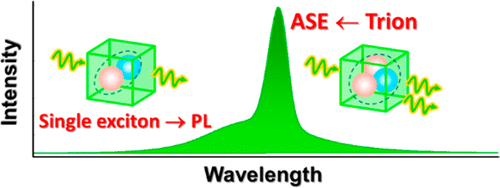当前位置:
X-MOL 学术
›
Nano Lett.
›
论文详情
Our official English website, www.x-mol.net, welcomes your
feedback! (Note: you will need to create a separate account there.)
Stable, Ultralow Threshold Amplified Spontaneous Emission from CsPbBr3 Nanoparticles Exhibiting Trion Gain
Nano Letters ( IF 9.6 ) Pub Date : 2018-07-16 00:00:00 , DOI: 10.1021/acs.nanolett.8b01817 Yi Wang 1 , Min Zhi 1 , Yu-Qiang Chang 2 , Jian-Ping Zhang 2 , Yinthai Chan 1
Nano Letters ( IF 9.6 ) Pub Date : 2018-07-16 00:00:00 , DOI: 10.1021/acs.nanolett.8b01817 Yi Wang 1 , Min Zhi 1 , Yu-Qiang Chang 2 , Jian-Ping Zhang 2 , Yinthai Chan 1
Affiliation

|
Wet-chemically synthesized cesium lead halide nanoparticles have many attractive properties that make them promising as optical gain media, but generally suffer from poor stability under ambient conditions and an optical gain threshold that is widely believed to be dictated by the need for biexcitons. These conditions make it impractical for such particles to be utilized as gain media given the need to undergo repeated stimulated emission processes at above-threshold pump intensities over long periods of time. We demonstrate that the surface treatment of CsPbBr3 nanoparticles with a mixture of PbBr2, oleic acid, and oleylamine not only raises their fluorescence quantum yield to nearly unity and prolongs their stability in air from days to months, but it also dramatically increases their trion photoluminescence lifetime from ∼0.9 to ∼1.6 ns. Via a combination of time-resolved photoluminescence and transient absorption spectroscopy, we provide evidence for trion gain at sufficiently low pump intensities in which the likelihood of predominantly biexciton-based gain is small. We then show that, in line with theoretical prediction, the amplified spontaneous emission (ASE) threshold of a thin film of surface-treated CsPbBr3 nanoparticles reduces to a record low of ∼1.2 μJ/cm2 with a corresponding average exciton occupancy per nanoparticle of 0.62. The ultralow pump threshold and increased stability allow for stable ASE over millions of laser shots, paving the way for the deployment of these nanoparticles as viable solution-processed optical gain media.
中文翻译:

具有Trion增益的CsPbBr 3纳米粒子稳定,超低阈值放大自发发射。
湿化学合成的卤化铯铅纳米颗粒具有许多吸引人的性能,使其有希望用作光学增益介质,但通常在环境条件下稳定性较差,并且光学增益阈值通常被认为是由于对双激子的需求所决定的。考虑到需要长时间在高于阈值的泵浦强度下进行重复的受激发射过程,这些条件使得将此类颗粒用作增益介质是不切实际的。我们证明了CsPbBr 3纳米粒子与PbBr 2混合物的表面处理,油酸和油胺不仅将其荧光量子产率提高到几乎统一,并且将其在空气中的稳定性从数天延长至数月,而且还将三酮的光致发光寿命从约0.9 ns大幅提高至约1.6 ns。通过时间分辨光致发光和瞬态吸收光谱的结合,我们为泵浦强度足够低的三重子增益提供了证据,在这种泵浦中,主要基于双激子的增益的可能性很小。然后,我们证明与理论预测一致,经表面处理的CsPbBr 3纳米颗粒薄膜的放大自发发射(ASE)阈值降低至约1.2μJ/ cm 2的创纪录低点。每个纳米粒子的平均平均激子占有率为0.62。超低的泵浦阈值和更高的稳定性使ASE在数百万次激光照射中保持稳定,从而为将这些纳米颗粒作为可行的溶液处理光学增益介质铺平了道路。
更新日期:2018-07-16
中文翻译:

具有Trion增益的CsPbBr 3纳米粒子稳定,超低阈值放大自发发射。
湿化学合成的卤化铯铅纳米颗粒具有许多吸引人的性能,使其有希望用作光学增益介质,但通常在环境条件下稳定性较差,并且光学增益阈值通常被认为是由于对双激子的需求所决定的。考虑到需要长时间在高于阈值的泵浦强度下进行重复的受激发射过程,这些条件使得将此类颗粒用作增益介质是不切实际的。我们证明了CsPbBr 3纳米粒子与PbBr 2混合物的表面处理,油酸和油胺不仅将其荧光量子产率提高到几乎统一,并且将其在空气中的稳定性从数天延长至数月,而且还将三酮的光致发光寿命从约0.9 ns大幅提高至约1.6 ns。通过时间分辨光致发光和瞬态吸收光谱的结合,我们为泵浦强度足够低的三重子增益提供了证据,在这种泵浦中,主要基于双激子的增益的可能性很小。然后,我们证明与理论预测一致,经表面处理的CsPbBr 3纳米颗粒薄膜的放大自发发射(ASE)阈值降低至约1.2μJ/ cm 2的创纪录低点。每个纳米粒子的平均平均激子占有率为0.62。超低的泵浦阈值和更高的稳定性使ASE在数百万次激光照射中保持稳定,从而为将这些纳米颗粒作为可行的溶液处理光学增益介质铺平了道路。











































 京公网安备 11010802027423号
京公网安备 11010802027423号